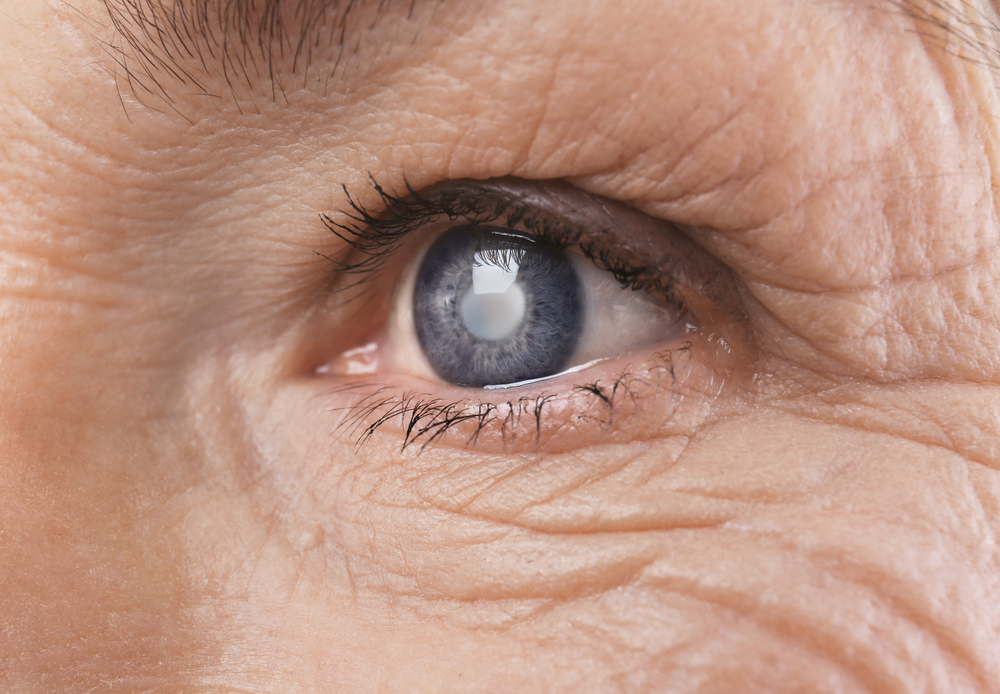What is a Cataract?

A cataract is a clouding of the natural lens inside your eye. The natural lens sits behind the iris and pupil. It works much like the lens of a camera. It focuses incoming light onto the retina at the back of the eye, where an image is recorded.
The lens is made of mostly water and protein, similar to the substance of an egg white. If you’ve ever fried an egg, you’ve probably noticed that the egg white gradually becomes cloudy, then turns white. The same changes happen to the lens of the eye as cataracts form, and the cloudiness makes it more difficult to see clearly.
When a cataract is mild, many patients can see better by using stronger lighting and changing their glasses. At some point, the lens gets cloudy enough that more light and stronger glasses don’t help anymore.
People often describe their vision as hazy, dim, or foggy, and the decrease in vision can affect the ability to see well for activities such as reading and driving. This is generally when cataract surgery is considered, though sometimes cataract surgery is done for reasons other than vision.
What are the Symptoms?






These symptoms can sometimes be caused by other eye problems, so it is important to check with your eye doctor if you are having these symptoms.
What Causes a Cataract?
For many people, cataracts are a normal part of the aging process. Cataracts can also be caused by certain diseases, medications, or an injury to the eye. Excessive exposure to UV light may also lead to cataract development.
How Does My Doctor Know if I Have a Cataract?
Your eye doctor uses all the information gathered during an exam to determine if you have a cataract, and how much it is affecting your vision. During an exam, your vision is measured, a refraction is performed, and your pupil is dilated. The doctor then evaluates your visual measurements and looks directly at the lens of your eye to determine the level of cataract. Other tests may be done, depending on your individual situation.
Are You a Candidate for Cataract Surgery?
Take our self-test and find out!
How are Cataracts Treated?
The treatment for cataracts is surgery, and surgery may be recommended when you have more difficulty seeing for daily activities (reading, driving, seeing the computer, etc.).
During cataract surgery, the surgeon will make a small incision on the side of the cornea.
A small probe is inserted into the eye to break up and remove your natural lens. Because your natural lens accounts for about 1/3 of your eye’s ability to see, a man-made lens is used to replace your natural lens. This is called an intraocular lens, or IOL. This lens is very similar to a contact lens, but because it is placed inside the eye, you do not have to care for it and you will not feel it.
Cataract surgery is very successful. More than 95% of patients have improved vision after surgery.
What Happens Before Surgery?
The first step is to get a consultation with a cataract surgeon. You may have had a recent exam with your optometrist or ophthalmologist who suggested that you should consider cataract surgery. The surgeon must still do a complete examination of your eyes before the final decision for surgery is made.
Before surgery, you will have special measurements taken of your eyes. These provide your surgeon with information to help choose the correct IOL for your surgery.
Most patients will start eye drops the day before surgery, and continue them for 4-6 weeks afterward.
Will I Have Limitations After Surgery?
You may have heard people who had surgery years ago tell you that you can’t bend, lift, or even tie your shoes after surgery. Today, most people don’t have these limitations. You will be taking eye drops for about 4-6 weeks after surgery. After surgery, you are not allowed to wear eye make-up for 1 week; you should avoid swimming or hot tubs for 2 weeks and be careful not to rub the eye during this time.
You will not be allowed to drive until your vision meets legal driving requirements, though most patients can drive within 2-3 days after surgery. Otherwise, most patients do not have any additional restrictions and can resume their normal activities soon after surgery.
Will My Cataract Come Back?
Because your natural lens is removed during surgery, your cataract cannot come back. Some people develop some cloudiness on the membrane that holds your IOL in place. Cloudiness of this membrane can cause similar symptoms to that of a cataract, such as blurred vision and glare symptoms. When this happens, the doctor can use a special laser to make an opening in the membrane to clear your vision.















